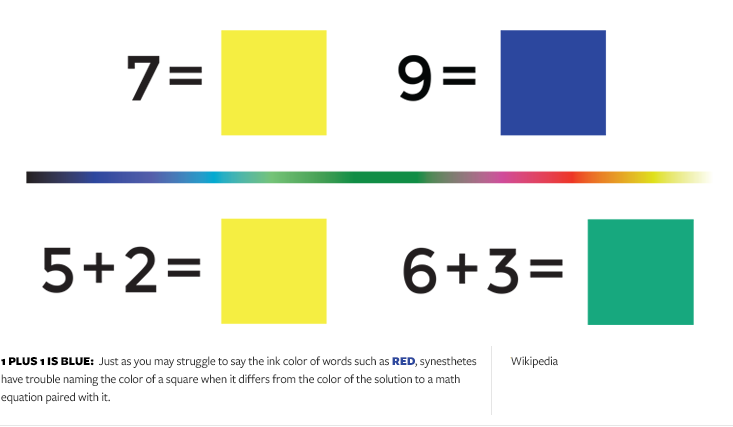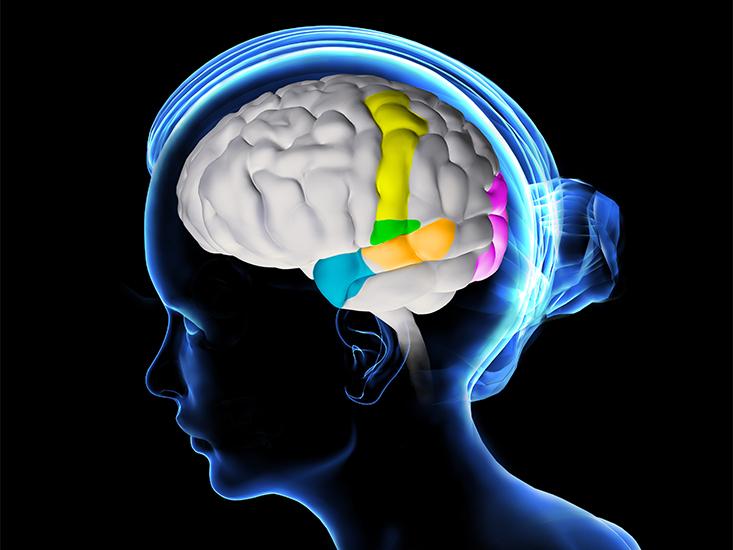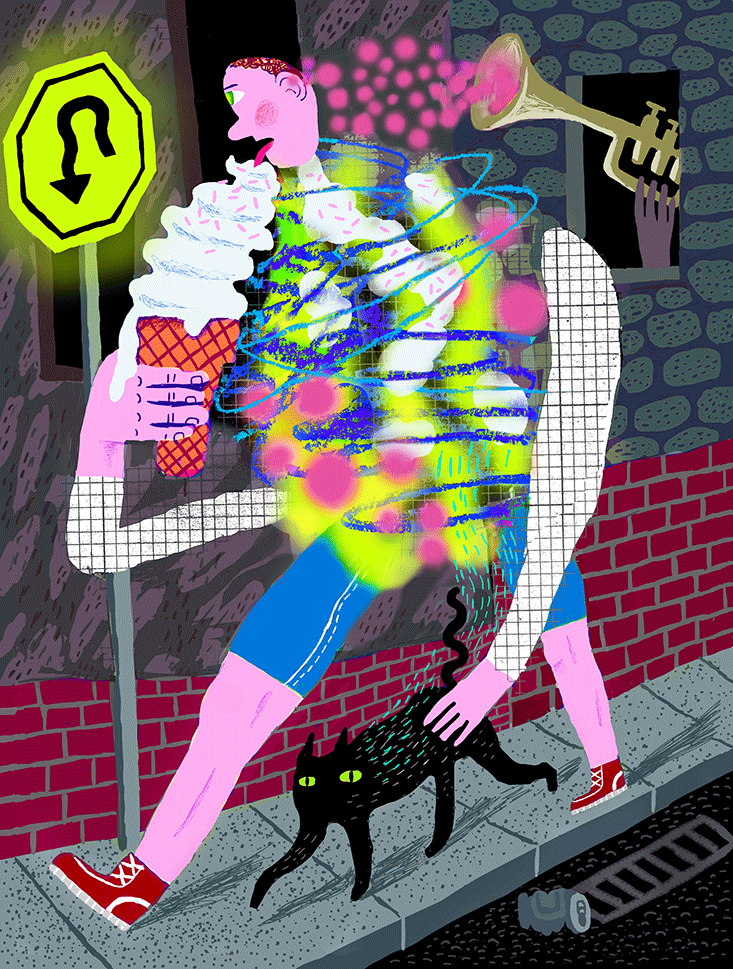My tongue is orange!” my 2-year-old daughter shrieked after licking a dollop of clear hand sanitizer. More orange experiences followed. “Mommy, my ear feels orange,” she moaned when an earache struck. “Mitten off! It’s orange,” she whined from inside her snowsuit when a scratchy tag in her new white glove rubbed uncomfortably against her wrist. As her vocabulary blossomed, she started to associate colors with scents. “What’s that brown smell?” (A local coffee roaster.) “What smells pink?” (Dryer exhaust puffing out of a neighbor’s basement vent.)
Anyone who has spent time around toddlers knows they say some strange things. But my daughter’s curious way of talking about colors was so emphatic, and so consistent, that I began to wonder if she might be experiencing synesthesia—a kind of cross-wiring of the senses that can evoke flavors from sounds, tastes from words, or colors from smells.
Since 1812, when an Austrian doctor first described his own propensity to see numbers and letters in their own distinct hues, researchers have documented more than 50 forms of synesthesia.1 The novelist Vladimir Nabokov wrote that the letter F assumed the green of an alder leaf, while the letter Z took on the dark blue of a thundercloud. The neurologist Richard Cytowic once met a synesthete who could feel with his hands cold, glass columns every time he inhaled spearmint. Another of Cytowic’s subjects reported tasting poached eggs when he heard the name Steve.
Because the brains of babies and synesthetes share common features, it’s possible that an infant’s perception may look a lot like an extreme case of synesthesia.
Yet despite its extraordinary nature, synesthesia is remarkably common. Studies estimate that up to 5 percent of adults have some form of the condition, including as many as 16 million people in the United States alone. But even if my daughter doesn’t grow up to be part of that statistic, her obsession with color may signify more than just an overly vivid imagination.
Some researchers suspect that we are all born with perceptual abilities like those of synesthetes.2 In the absence of synesthesia, the adult brain mostly processes information about the outside world through separate sensory systems—one for vision, another for touch, and so on. But in the mind of a baby, the senses are less distinct; the environment may exist as a kind of undefined blur. “Babies aren’t seeing mom versus hearing mom versus smelling mom,” says Daphne Maurer, an expert in the development of perception at McMaster University, in Ontario. “They’re just experiencing ‘mom-ness.’ ” Perhaps my daughter is expressing the weird sensory realm that all very young children inhabit but only synesthetes can still visit later in life.

We may never know exactly how infants perceive the world because they can’t tell us. “But it’s very possible it’s a complete mess to them,” says Nicholas Root, a doctoral student studying synesthesia at the University of California, San Diego. Studies in animal and human infants suggest that when we’re born, the brain regions responsible for handling input from our eyes, skin, and other sensory organs aren’t yet specialized. When babies look at faces, for example, their brains show activity in vision centers as well as areas that process language and sound. Similarly, when babies listen to human speech, the auditory regions activate along with the visual regions.
This cross-activation implies that the sensory areas in the infant brain are knitted together in a cat’s cradle of neural links. “Soon after birth, you have the most connections you’ll ever have in the brain,” says Jamie Ward, a cognitive neuroscientist at the University of Sussex. As you mature, the useful connections strengthen while the idle ones weaken or disappear. What starts out as a tangled thicket of sensory branches gets pruned into a tidy topiary.
Precisely how the extra crosslinks in babies’ brains affect perception is something of a mystery. But the experiences of synesthetes may offer a clue. Neuroimaging studies show that, like infants, adults with synesthesia have more physical connections between sensory processing areas than do other adults.3 And one type of stimulation can similarly engage multiple sensory areas. In synesthetes who see colors in sounds, for example, spoken words activate a part of the brain associated with color vision.4
These observations have led some scientists to conclude that people with synesthesia keep some of the cross-sensory connections they were born with. Other researchers suspect that higher-order brain centers, which typically shush superfluous communication between sensory regions, don’t completely stop the gossip. In either case—and both may be true—the result is the same: The senses never fully disentangle.
As newborns, we take in nearly everything because we don’t yet know what’s important. But as useless connections get silenced or trimmed away, a more efficient brain emerges.
Because the brains of babies and synesthetes share common features, it’s possible that an infant’s perception may look a lot like an extreme case of synesthesia. Behavioral studies support this theory. In a 2011 paper, psychologist Karen Dobkins and doctoral student Katie Wagner at the University of California, San Diego presented babies with circles and triangles displayed on differently colored backgrounds. The researchers found that at 2 to 3 months, the infants favored certain shape-color pairings, and, like adult synesthetes, their preferences differed from person to person. By 8 months, however, babies didn’t seem to care whether a circle was blue or a triangle was yellow.5
For some people, early synesthesia-like gifts may endure even longer and continue developing. In a 2013 study, Julia Simner, a psychologist at the University of Sussex, tested more than 600 kids between ages 6 and 7 for signs of grapheme-color synesthesia, in which letters and numbers take on distinct hues. She identified eight children who consistently paired certain colors to about one-third of all Arabic numerals and English letters. A year later, they matched nearly half of these graphemes to a fixed color. And by age 10 and 11, five of the eight children appeared well on their way to becoming full-blown synesthetes—they colored 70 percent of the numbers and letters in a routine way. The other three kids, meanwhile, seemed to have lost at least some of their synesthetic ability.6
The possibility that my daughter began life as a synesthete is in one sense delightful. To her, a hummed lullaby might literally have felt like a hug. A tickle to the toes might have invoked a shimmering rainbow before her eyes. On the other hand, this sensory mélange might explain why it’s so easy to overstimulate a newborn. “If the parents turn on the light, start to sing in a loud voice, or bump into the crib, to a baby that might be equivalent to screaming at the top of your lungs,” Maurer says.

Whether heart-warming or hair-raising, an infant’s perceptual mash-up likely serves an evolutionary advantage. The abundant sensory connections in a newborn brain may allow babies to adapt to the peculiarities of their particular time, place, and culture. If the senses were hard-wired at birth, “there would be lots of ways that could go amok,” Maurer says. Instead, “what’s built in is this mechanism of ‘use it or lose it.’ ”
A baby’s brain is constantly learning which sensory inputs represent real information and which signals are just “noise in the system,” Maurer explains. As newborns, we take in nearly everything because we don’t yet know what’s important. But as useless connections get silenced or trimmed away, a more efficient brain emerges. Sensory regions become specialized and streamlined, able to tune out neural noise and home in on the messages that matter for our survival.
In the first few months of life, for example, infants can tell the difference between two faces regardless of the subjects’ ethnicity. By the time they turn a year old, however, babies can more easily distinguish faces from their own culture than faces from other cultures. Similarly, young infants are pretty good at discriminating a wide variety of speech sounds. But by their first birthdays, they no longer notice differences that are irrelevant to their native language. Children born into Spanish-speaking families, for example, lose the ability to differentiate between “va” and “ba,” which are used interchangeably. Babies exposed to English similarly stop being able to contrast two “da” sounds important in Hindi—one made with the tongue at the front of the mouth, the other made with the tongue to the side.
Maurer views these findings as further evidence that a baby’s perceptual world exhibits many of the characteristics of synesthesia. In her work with adult synesthetes, she has found that they retain some ability to distinguish between foreign faces and speech sounds as babies do. Although they don’t do as well as culture-blind infants, they do a significantly better job than non-synesthetes.
The vast majority of people with synesthesia say their worlds are richer for it.
Even in typical adults, the pruning process might not be absolute. Like rope bridges stretched between islands, some of the neural connections between sensory areas that exist in the infant brain may linger into adulthood. And those links might bias us to make certain associations between sensory objects, often without knowing it. “There are remnants of this early wiring in all of us,” Maurer says. “It doesn’t affect our full-blown conscious perception, but it’s there in our behavior.”
Take the perception of color and pitch. Studies show that both children and adults without synesthesia match lower-pitched sounds with darker objects and higher pitches with lighter objects, even though they don’t consciously perceive these sounds as having intrinsic colors, as synesthetes do.7 Maurer and Ferrinne Spector, a former graduate student and now a professor of psychology at Edgewood College, in Madison, Wisconsin, have found similar universal biases between colors and scents, textures and letters of the alphabet.
Some of these associations can be explained by experience—green for the letter G, yellow for the scent of a lemon. But other biases may be part of our neural architecture and probably help us learn, Spector says. Mentally linking larger objects with louder sounds, for example, is in line with the way the world works. Elephants sound louder than mice. Having a ready-made intuition about such natural rules could give babies a jumpstart on making sense of their environment.
Still, many patterns are puzzling. In a study of 78 adults without synesthesia, volunteers described the smell of ginger as black, rough, and sharp more often than chance. Lavender, meanwhile, was green or white, liquid, and sticky.8 Studies of adults and pre-literate toddlers likewise reveal unconscious pairings between the letters O and I with the color white, and between the letters X and Z with the color black.
These strange sensory unions may be artifacts of the way our brains are wired, Spector speculates. Our tendency to match light colors with high pitches, for instance, may be a side effect of how our brains understand frequency. Or it may simply be a shadow of our infant viewpoint—a lurking reminder that we all started life surrounded by a swirling cloud of sounds and smells, tastes and textures, contours and colors.

In Sean Day’s sensory universe, beer tastes turquoise. Freshly cut grass smells deep purple with a lavender streak. Notes from a piano look like a cloud of sky blue.
Day is an anthropology instructor at Trident Technical College in South Carolina and the president of the American Synesthesia Association. For as long as he can remember, he has experienced colors in flavors, scents, and sounds. In his spare time, he likes to cook and compose music, and his synesthesia inspires his recipes and compositions. “I’ll deliberately go after certain color combinations that are vivid and flashy,” he says. “Dark purple with orange is really good—green leafy vegetables are dark purple; raspberries are orange.” Electric sounds and echo effects likewise create flamboyant color fusions.
Some synesthetes find their condition distracting or overwhelming. Try learning math when the color of the answer doesn’t match the colors of the digits you’ve just added together. Or navigating Times Square when every word on every billboard multiplies the colors and shapes flashing before your eyes. But the vast majority of people with synesthesia say their worlds are richer for it. Day, for one, knows he would miss his musical and savory hues if they disappeared. Because one day they did.
In 1999, he was living in Taiwan when the Jiji earthquake struck, killing more than 2,000 people. “There were aftershocks; no water,” he recalls. “Destruction all around.” In the days that followed, his synesthesia mysteriously vanished—a symptom of stress, he thinks. For four months, food seemed drab; music was dull. Then finally, their colors returned. “If they hadn’t come back, it would have been a pity—a loss.”
My daughter will turn 3 in October. She hasn’t described pain or discomfort as “orange” in months. She rarely paints scents in the language of color. When I press her to characterize an aroma, she looks at me with confusion. If she did experience some kind of synesthesia in her first two years of life, the ability seems to be slipping away.
I can’t help but feel wistful for the vibrant Kodachrome world she might have lived in and might now be leaving behind. I long to see what she saw when her ear throbbed orange, when she inhaled a deep breath of pink-tinged air. It’s comforting, though, to think that the ghosts of those colorful moments may still reside deep in her brain, as they may in mine. One spring day, when the lilacs are in full bloom, we may walk outside and together smell the green sticky air—for a brief moment, inhaling the world again through the kaleidoscopic mind of a baby.
Kirsten Weir is a freelance science writer in Minneapolis.
References
1. Ward, J. Synesthesia. Annual Review of Psychology 64, 49-75 (2013).
2. Spector, F. & Maurer, D. Synesthesia: A new approach to understanding the development of perception. Developmental Psychology 45, 175-189 (2009).
3. Rouw, R. & Scholte, H.S. Increased structural connectivity in grapheme-color synesthesia. Nature Neuroscience 10, 792- 797 (2007).
4. Nunn, J.A., et al. Functional magnetic resonance imaging of synesthesia: Activation of V4/V8 by spoken words. Nature Neuroscience 5, 371-375 (2002).
5. Wagner, K. & Dobkins, K.R. Synaesthetic associations decrease during infancy. Psychological Science 22, 1067-1072 (2011).
6. Simner, J. & Bain, A.E. A longitudinal study of grapheme-color synesthesia in childhood: 6/7 years to 10/11 years. Frontiers in Human Neuroscience 7:603 (2013).
7. Spector, F. & Maurer, D. The colors of the alphabet: Naturally-biased associations between shape and color. Journal of Experimental Psychology: Human Perception and Performance 37, 484-495 (2011).
8. Spector, F. & Maurer, D. Making sense of scents: The color and texture of odours. Seeing and Perceiving 25, 655-677 (2012).



























